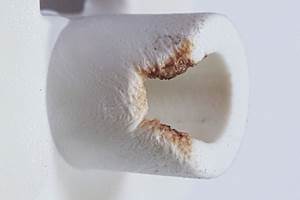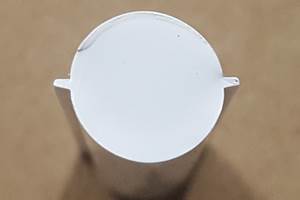Where Does Shear Heating Occur? Here’s How to Find Out
One of the least understood yet most important concepts is viscous dissipation, which is the shearing or stretching of the polymer between the rotating screw and stationary barrel, causing heat to develop in the material.
Screws can be somewhat mystifying from outside the barrel because of their seemingly complex geometry and their interacting functions of melting, conveying, pressurizing,and mixing. One of the least understood yet most important concepts is viscous dissipation, which is the shearing or stretching of the polymer between the rotating screw and stationary barrel, causing heat to develop in the material. In single screws, as much as 90% of the drive power is used in this way to heat and melt the polymer.
The highest shear stress and resultant polymer heating takes place just inside the inner surface of the barrel, as shown by the red area in the accompanying illustration. If you consider the heat flow shown for the screw/barrel section as illustrated, it is apparent that a lot of energy that is being converted to heat near the barrel wall can easily flow into the barrel, since it is a hundred times better conductor of heat than the polymer.
One way to get some clues about the location and magnitude of this shear heating is to temporarily turn off the barrel cooling and observe the change in zone temperatures. Some barrel-cooling systems are so effective they completely mask the heating effects that may be occurring in the system. The analysis would seem to be somewhat complicated by the viscosity decreasing as the polymer traverses the length of the barrel. However, that does not affect the validity of the test, as we are looking for zones that appear to be a “hot spot” and not absolute numbers.
If we observe a hot spot what does that tell us? Well, it says that a lot of mechanical energy is being converted to heat at that location. With some knowledge of screw design, we can determine if high shear stress would be predicted in that area and use that information to troubleshoot the performance of the screw.
One example would be a hot spot in the zone near the end of the feed section, the early part of the compression section, or the start of the barrier section. That usually indicates an area that is restricting the polymer flow from the feed section and could resulte from either over-feeding or compression that is too abrupt. That could cause a surge, a disruption in the melting pattern, and consume a lot of power that was mostly going into the barrel.
Another possible cause could be a mixing section that is being plugged with unmelted polymer. If that mixer is at or near the end of the screw, it can cause a non-uniform melt temperature in addition to adding significant overall temperature to the melt.
A third potential culprit would be a hot spot near the end of a barrier section, indicating that a lot of solids were still remaining to be melted at the end of the barrier section, necessitating a change in screw design.
In addition to helping analyze screw performance, knowing where the shear heating is occurring in your extruder can guide you to the best temperature profile. Since one of the main purposes of the extruder is to raise the temperature of the polymer, it makes sense to work with the equipment rather than against it.
Allowing the extruder to put the heat in (or take it out) where the screw is designed to do that will generally result in more stable operation and more efficient power usage. That’s not to say that such analysis will solve all your processing problems, but it is another tool to use in analyzing screw performance and extruder control.
Related Content
Back to Basics on Mold Venting (Part 1)
Here’s what you need to know to improve the quality of your parts and to protect your molds.
Read MoreThe Effects of Stress on Polymers
Previously we have discussed the effects of temperature and time on the long-term behavior of polymers. Now let's take a look at stress.
Read MoreWhere and How to Vent Injection Molds: Part 3
Questioning several “rules of thumb” about venting injection molds.
Read MoreInjection Molding: Focus on these Seven Areas to Set a Preventive Maintenance Schedule
Performing fundamental maintenance inspections frequently assures press longevity and process stability. Here’s a checklist to help you stay on top of seven key systems.
Read MoreRead Next
For PLASTICS' CEO Seaholm, NPE to Shine Light on Sustainability Successes
With advocacy, communication and sustainability as three main pillars, Seaholm leads a trade association to NPE that ‘is more active today than we have ever been.’
Read MoreMaking the Circular Economy a Reality
Driven by brand owner demands and new worldwide legislation, the entire supply chain is working toward the shift to circularity, with some evidence the circular economy has already begun.
Read More
.jpg;width=70;height=70;mode=crop)












